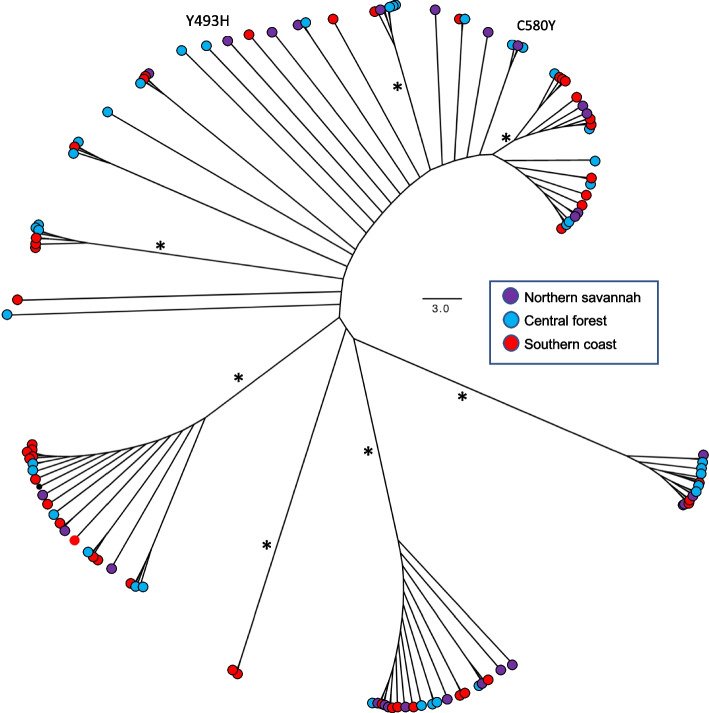Our Latest Publications
Distribution of Plasmodium falciparum K13 gene polymorphisms across transmission settings in Ghana
In this study, we compared Pfk13 sequences obtained from 172 P. falciparum samples across three ecological and transmission zones in Ghana. We identified 27 non-synonymous mutations among these sequences, of which two of the mutations, C580Y (found in two samples from the central region) and Y493H (found in one sample from the north), had previously been validated for their association with artemisinin resistance, a phenomenon widespread in Southeast Asia.
Genetic variations of Plasmodium falciparumcircumsporozoite protein and the impact on interactions with human immunoproteins and malaria vaccine efficacy
Twenty-seven PfCSP haplotypes were detected in the Ghanaian samples, and they broadly represented PfCSP diversity across Africa. The number of genetic differences between 3D7 and non-3D7 PfCSPvariants does not influence binding to HLA. However, CSP peptide length after proteolytic degradation significantly affects its molecular weight and binding affinity to HLA. Despite the high diversity of HLA, the majority of the HLAI and II alleles interacted/bound with all Ghana CSP peptides. Multiple non-3D7 strains among P. falciparum infections could impact the effectiveness of RTS,S. Longer peptides of the Th2R/Th3R CSP regions should be considered in future versions of RTS,S.
Prevalence and characteristics of Plasmodium vivax Gametocytes in Duffy-positive and Duffy-negative populations across Ethiopia
398 Duffy-positive P. vivax-infected samples, 150 (37.7%) were detected with gametocytes, slightly higher than that in Duffy-negatives. This study highlights the presence of P. vivax gametocytes in Duffy-negative infections. Although P. vivax infections in Duffy-negatives are commonly associated with low parasitemia, some of these infections were shown with relatively high parasitemia and may represent better erythrocyte invasion capability of P. vivax and hidden reservoirs that can contribute to transmission.
Gene Polymorphisms Among Plasmodium vivax Geographical Isolates and the Potential as New Biomarkers for Gametocyte Detection
We compared genetic variations of 15 and 11 genes expressed, respectively, in the female and male gametocytes among P. vivax isolates from Southeast Asia, Africa, and South America. Further, we constructed phylogenetic trees to determine the resolution power and clustering patterns of gametocyte clones. Pvs25 (PVP01_0616100) and Pvs16 (PVP01_0305600) expressed in the female gametocytes were highly conserved in all geographical isolates. Pvs230(PVP01_0415800) and upregulated in late gametocytes ULG8 (PVP01_1452800) expressed in the female gametocytes, as well as two CPW-WPC family proteins (PVP01_1215900 and PVP01_1320100) expressed in the male gametocytes indicated considerably high nucleotide and haplotype diversity among isolates.
Prevalence and distribution of Plasmodium vivax Duffy Binding Protein gene duplications in Sudan
A total of 200 malaria-suspected blood samples were collected from health facilities in Khartoum, River Nile, and Al-Obied. Among them, 145 were confirmed to be P. vivax, and 43 (29.7%) had more than one PvDBP copies with up to four copies being detected. Both the Malagasy and Cambodian types of PvDBP duplication were detected. The functional significance of PvDBP duplications, especially those Malagasy-type that associated with higher parasitemia, merit further investigations.
Nationwide Surveillance of Pfhrp2 Exon 2 Diversity in Plasmodium falciparum Circulating in Symptomatic Malaria Patients Living in Ghana
81% (2,333/2,890) of the original microscopy positive DBS were available and used in this study. The Pfhrp2 exon 2 amplification was successful in 98.5% (2,297/2,333) of the tested samples, with band size ranging from 400 bp to 1,050 bp. A total of 13 out of the 24 previously reported repeat types were identified among the samples, with three samples lacking both type 2 and type 7 repeat motifs. This study suggested that the genetic diversity of Pfhrp2 exon 2 identified in P. falciparum circulating in symptomatic malaria patients in Ghana is unlikely to influence the sensitivity and specificity of HRP2 RDT-based diagnosis.





